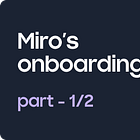Miro’s onboarding, the complete flow - part 2/2
Duplicate the Figma flow w/ the link at the end of this email.
This is the second part of the newsletter, where we break down each email in the flow and explore how to improve the copy.
We’ll analyze the full sequence, the logic behind it, and—most importantly—how it could be better.
Plus, you’ll get:
an alternative flow I would have built if I were running onboarding at Miro!
a secret technique that helps activate large teams 👀
In case you missed it, the part 1: 👇
Miro’s flow — what is the logic behind?
Miro is nailing one thing most SaaS companies struggle with—activation.
Their onboarding email flow is minimal, yet their activation rate is (probably) above target.
That proves how intuitive their product is—users don’t need much guidance.
But that’s not the reality for most SaaS products. Many require hand-holding until users reach the activation step.
3 points where Miro’s onboarding flow gets it right:
→ It stays focused. Every email has a clear goal—no distractions.
→ It’s concise. Users aren’t overwhelmed with unnecessary information.
→ It filters ICPs. Though a bit late in the flow, it segments users effectively.
But here’s the catch—simplicity comes at a cost.
Miro might leave money on the table by not leveraging data, personalization, and post-onboarding engagement.
How I’d redesign Miro’s onboarding flow
Miro’s current onboarding flow is simple—but it could be much smarter.
Here’s how I’d structure it for higher activation and engagement:
1️⃣ Segment users immediately
I’d filter ICPs as soon as they start using the product, not later.
But job title alone isn’t enough—seniority matters. A marketing manager and an operational specialist might be in the same department but have very different needs.
By identifying who they are and what they need early, emails can deliver the right CTAs and content for their specific job to be done.
2️⃣ Trigger emails based on in-app behavior
Instead of sending generic onboarding emails, I’d track key actions inside the product.
For Miro, inviting team members is a critical adoption factor. If a user hasn’t done it, an email should nudge them at the right time.
Rather than guessing what users need, let their behavior dictate the flow.
3️⃣ Use smart loops on key actions
If a user doesn’t complete an important action, following up is essential—but timing matters. I’d structure reminders so that each repeat CTA gets a +2-day delay (max 3 times).
This prevents spammy repetition while keeping users engaged. The goal is to remind, not annoy.
4️⃣ Activate secondary ICPs - the secret sauce technique
If the primary user (e.g., a CMO) isn’t engaging, that doesn’t mean the account is lost. Instead, I’d engage a secondary ICP—someone else within the company who could drive activation.
For example:
If the CMO hasn’t started a board in Miro, I’d send them a marketing campaign template they could share with their team.
This gives another entry point for engagement—without relying on a single person.
⚠️ Balancing segmentation
Be careful about over-segmentation.
Too many segments can create complexity that’s hard to optimize. However, when backed by data, segmentation becomes a strategic advantage.
Users today expect relevance, not generic emails.
At the same time, companies are collecting less user data than before. That’s why personalization must be meaningful—it needs to build trust first.
Final Takeaways
→ Segment early, but only where it truly matters.
→ Trigger emails based on meaningful in-app behaviors.
→ Don’t just nurture one user—activate the entire company.
→ Be persistent, but not pushy. Timing is everything.
When done right, this approach doesn’t just improve onboarding—it lays the foundation for long-term retention.
As promised, here’s the Figma file with the full flow that you can duplicate.
Feel free to like—it’s always appreciated! And drop a comment if you have any questions.
Have a great day, everyone!






